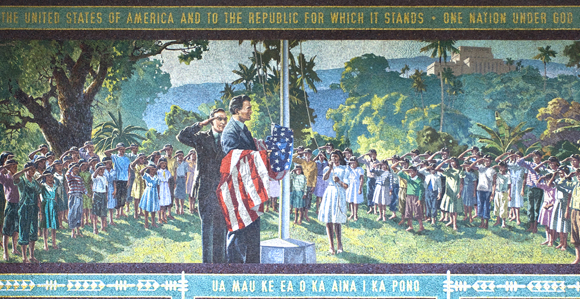BYU–Hawaii Commemorates 92 Years Since Historic Flag Raising
Contributed By Church News

A tile mosaic at BYU–Hawaii portrays the flag-raising ceremony in 1921 that then Elder David O. McKay attended.
Article Highlights
- In 1921, then Elder David O. McKay attended an American flag-raising ceremony in Laie, Hawaii, and saw an institution of higher learning that would bring students together from all across the globe.
- In February, current students held a flag-raising ceremony with representatives from 68 countries each hoisting their banners around the historic flag circle at BYU–Hawaii.
- With approximately 50 percent of students coming from countries outside of the United States, BYU–Hawaii is the “most international campus” in the U.S.
“It is humbling to see this fulfillment and to look forward to our responsibility now to ‘go forth to serve,’ as it says at the front of our campus.” —Alfredo P. Solar, a BYU–Hawaii senior from Mexico
LAIE, HAWAII
One of the most prominent displays on BYU–Hawaii’s Laie campus is the large tile mosaic showcasing an American flag-raising ceremony on February 7, 1921, attended by then Elder David O. McKay and Hugh J. Cannon. The two were on assignment from the First Presidency to visit Church members throughout the world when they stopped in Laie. It was at this flag-raising ceremony that Elder McKay, then of the Quorum of the Twelve and Church President from 1951 to 1970, saw an institution of higher learning that would bring students together from all across the globe and then send them back as learners, leaders, and builders in their respective countries.
On Saturday, February 16, against the backdrop of this mosaic in Laie, another flag-raising ceremony took place—this time with representatives from 68 countries each hoisting their banners around the historic flag circle at BYU–Hawaii. The event capped off the university’s Spirit Week 2013, a week of activities and celebration surrounding the institution’s groundbreaking in February 1955.
“I have read and seen so much about President David O. McKay’s vision from his 1921 visit to Laie and wanted to have as many students, alumni, and others as possible see a piece of the fulfillment of that vision,” said Alfredo P. Solar, a senior from Mexico who served on the Spirit Week 2013 organizing committee. “It is humbling to see this fulfillment and to look forward to our responsibility now to ‘go forth to serve,’ as it says at the front of our campus.”
Students from four of the more than 75 countries currently represented in the student body provided brief remarks at the early-morning gathering. Following the short program, participants took their places at each of the flagpoles in the flag circle, attached their nation’s banners, and all together hoisted their flags.
“As we place these flags today, may we be reminded that we are all part of God’s family,” said Michael B. Bliss, vice president of administrative services at BYU–Hawaii. “The founding of this university should have deep personal meaning for everyone who comes to this campus.”
With approximately 50 percent of students coming from countries outside of the United States, BYU–Hawaii is the “most international campus” in the U.S., according to a report by the Chronicle of Higher Education.
“This is a place where we learn to live together—people coming from different horizons, different cultural backgrounds, different countries,” said Nowah Afangbedji, a junior from Africa. “I’m forever grateful for people whose hands have laid the foundation of this school. I’m grateful to heaven for opening the mind of President McKay to see these things that I’m enjoying today. And I pray that blessings will be upon people who are still working hard for this prophecy to come true.”

BYU–Hawaii students proudly display flags from their countries, including Taiwan, Hong Kong, Tonga, Australia, Guam, India, and Sri Lanka, on February 16. BYU–Hawaii is the “most international campus” in the U.S. Photo courtesy BYU–Hawaii University Communications.
